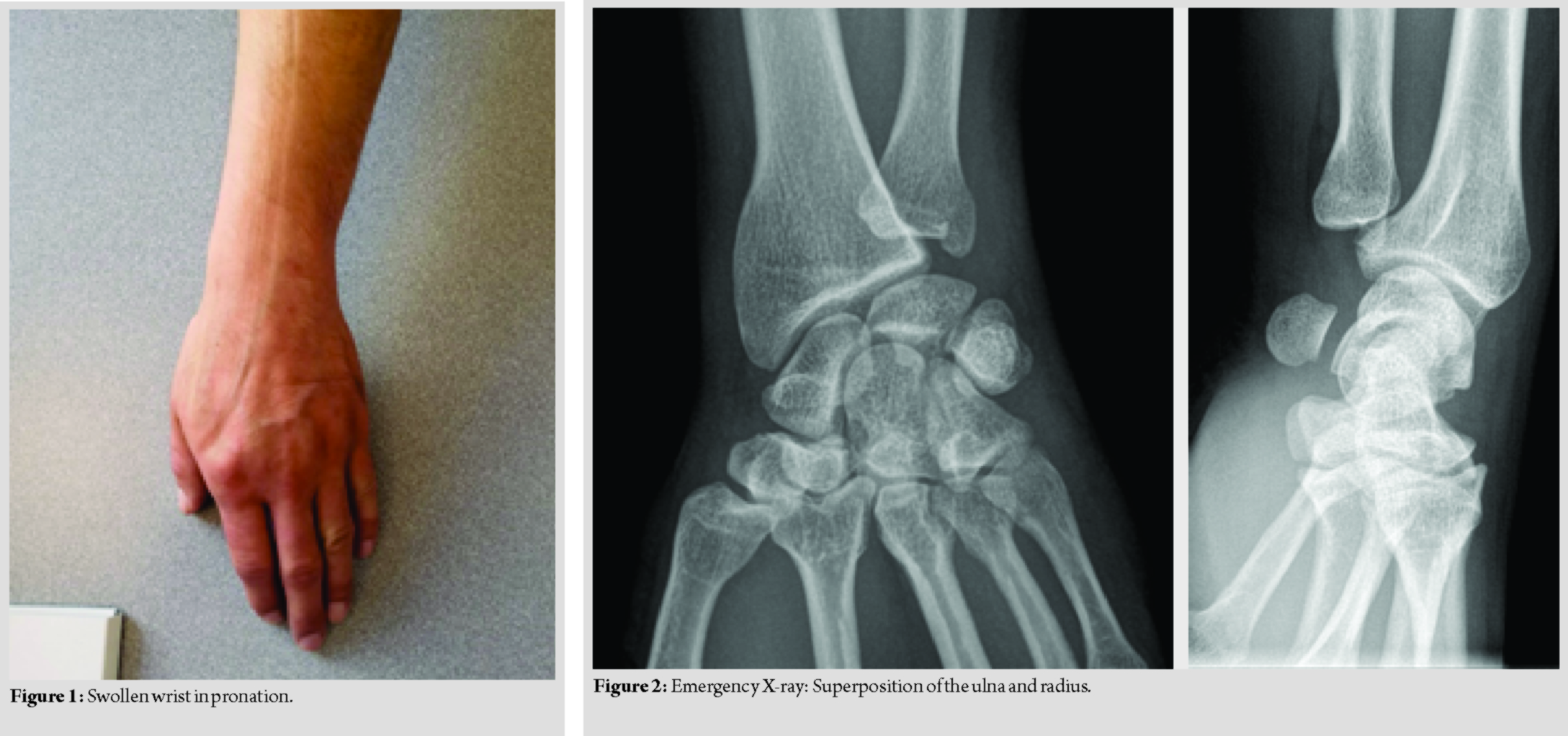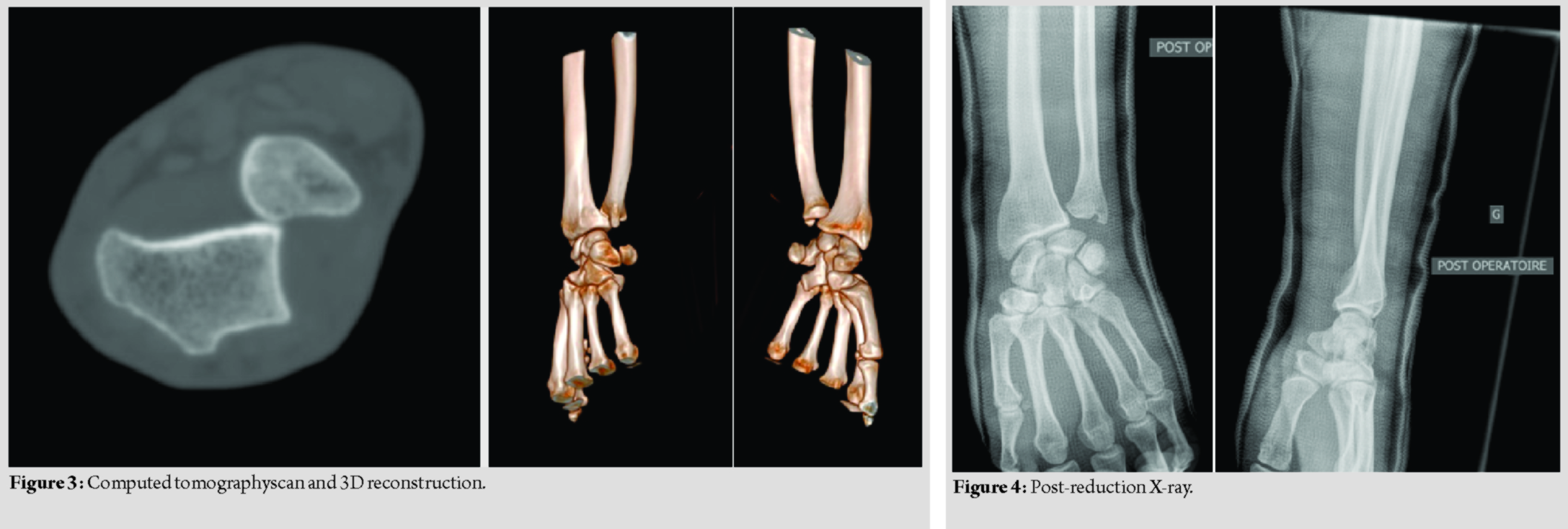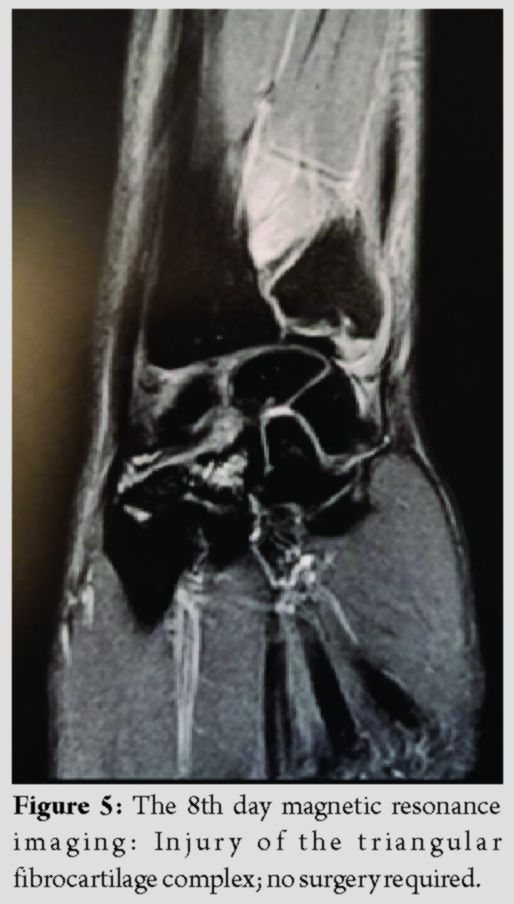[box type=”bio”] Learning Point of the Article: [/box]
Limitations in pronosupination of the DRUJ should alert the clinician to search for DRUJ dislocation. Mechanism of trauma orients the diagnosis. Clinic can be misleading and palpation of dislocation difficult due to edema. In case of doubt, the surgeon must use advanced radiological tools (i.e., CT scan).
Case Report | Volume 10 | Issue 2 | JOCR March – April 2020 | Page 97-100 | Ruben Dukan, S Kassab Hassan, J G Delvaque, I Khaled, R Nizard. DOI: 10.13107/jocr.2020.v10.i02.1716
Authors: Ruben Dukan[1], S Kassab Hassan[1], J G Delvaque[1], I Khaled[1], R Nizard[1]
[1]Department of Orthopaedic Surgery, University Hospital Lariboisiere, 75010, Paris.
Address of Correspondence:
Dr. Ruben Dukan,
Department of Orthopaedic Surgery, University Hospital Lariboisiere, 75010, Paris.
E-mail: ruben.dukan@gmail.com
Abstract
Introduction: Isolated dislocation of the distal radioulnar joint (DRUJ) is a rare phenomenon. Approximately 50% of isolated DRUJ dislocations are undiagnosed or diagnosed late with significant functional consequences. This clinical injury is rarely described in the literature and management is not well established. We reported a case of volar DRUJ dislocation early diagnosed.
Case Report: A 36-year-old man was diagnosed with an isolated volar dislocation of the DRUJ. The clinical examination, X-rays, and computed tomography scan allowed an early diagnosis. A reduction by external maneuvers was performed and the patient was immobilized in an above elbow plaster cast for 6 weeks. Magnetic resonance imaging did not reveal any capsuloligamentous lesions requiring surgery. Evolution was favorable.
Conclusion: Isolated volar dislocation of the DRUJ is an uncommon injury which can be easily missed. Missed or late diagnosis may lead to significant morbidity. Early diagnosis and treatment of such injuries usually results in excellent functional recovery.
Keywords: Volar dislocation, distal radioulnar joint, closed reduction.
Introduction
Isolated volar dislocation of the distal radioulnar joint (DRUJ) is an uncommon injury which can be easily missed. This injury is caused by extremely forceful pronation of the forearm on a fixed hand. Clinical deformation can be minimal on a mainly swollen wrist. Anteroposterior (AP) and lateral views of the wrist can help in the diagnosis without necessarily being obvious. These dislocations are mainly dorsal and are often associated with fractures of radius and/or ulna. In case of misdiagnosis, functional consequences are critical. Literature is lacking on this subject compared to traditional injuries (Galeazzi and Monteggia lesions) and treatment remains based on experience. Some authors recommend a maximal systematic surgical treatment combining open reduction, ligament suture, and stabilization using K-wires [1, 2]. For others, treatment can be non-operative[3, 4]. Type, position, and duration of immobilization remain to be defined. This case report describes a successful non-operative management of an acute isolated, non-complicated, and volar DRUJ dislocation. Dislocation was diagnosed in the emergency room and was reduced and treated immediately. The patient was informed that data concerning the case would be submitted for publication and agreed.
Case Report
A 36-year-old man, right-handed, manual worker, without medical background or hyperlaxity presented himself to the emergency room after an injury of the upper right limb. The patient was a sportsman, martial arts competitor. Trauma was related to an accident on the public road (electric scooter). Fall was described as wrist in pronation and hyperextension. On arrival, the patient reported a severe localized pain in the DRUJ. Wrist was in pronation (Fig. 1). 
The patient was immobilized in an above-elbow plaster cast for 6 weeks with the wrist in supination. At 8 days, a magnetic resonance imaging (MRI) was performed to complete the assessment of ligament injuries. No lesions of the interosseous membrane were found. A disruption of the triangular fibrocartilage complex (TFCC) at the ulna styloid and injury to the ligamentum subcruentum was found without the need for surgical intervention (Fig. 5). The patient was clinically and radiographically reassessed at the 2nd, 4th,and 6th weeks. At the control X-rays, ulna was in a satisfactory position allowing the plaster to be removed at the 6th week. An active physiotherapy was started at a rate of 3 sessions per week. The patient was seen again at the 12th week. Wrist was painless and stable both in flexion-extension (80°–50°) and pronation-supination (70°–70°). Control X-rays showed a non-arthritic wrist. The patient began to work at the 9th week. Martial arts began at the 14th week without limitation. The patient was assessed at the 6th month and 1 year. Ranges of motion at each assessment are resumed in [Table 1]. There were no sequelae and no evidence of arthrosis on the X-ray. Quick Dash at the last follow-up was equal to 0.
Discussion
Isolated dislocation of the DRUJ is a rare phenomenon. This dislocation, which the direction is determined by the position of the ulna relative to the radius, is mainly dorsal and rarely volar. Thus, approximately 50% of isolated DRUJ dislocations are undiagnosed or diagnosed late with significant functional consequences. This clinical injury is rarely described in the literature with only 15 cases and various treatments [1, 2, 3, 4, 5, 6, 7, 8, 9, 10, 11, 12, 13, 14,15]. Management is not well established (closed reduction/closed reduction + stabilization/open reduction + stabilization), and clinical and radiological arguments will guide the surgeon. Surgeon may be misled by the clinical presentation of this injury. Clinical examination is poor, the patient keeps a flexion-extension of the wrist. A slight pronation can be observed (in this case 5° of pronation). The volar tilt of the ulna can be felt. Lateral view is the most significant X-ray in evaluation for DRUJ dislocation but may also be difficult to perform due to the patient pain and limited range of motion. If there is any doubt, a CT scan should be performed. Stability of the DRUJ is ensured mainly by the TFCC [16]. The pronator quadratus and the extensor carpi ulnaris muscles providing its dynamic stability. During supination, the radius rotates about the fixed ulna. The superficial volar and the deep dorsal radioulnar ligament fibers tighten while the deep volar and superficial dorsal fibers become lax. In pronation, the opposite occurs. Dislocation of the DRUJ is usually associated with damage to the supporting joint structures, including the ulnar collateral ligament, the triangular fibrocartilage, the anterior and posterior radioulnar ligaments, and the pronator quadratus [17, 18]. Thus, the dislocation will be reducible or not depending on the incarceration of one or more of these soft tissues. In case of irreducibility or instability after reduction, an open reduction with debridement and stabilization will be necessary. Authors found a risk factor of subluxation/dislocation [19, 20, 21]: A significantly larger arc of the articular surface of the distal radius compared to the smaller arc of the distal ulnar articular surface. The potential lesions of the capsuloligamentous structures around the DRUJ are important to diagnose[22, 23]. Diagnostic MRI performed 5–8 days after the injury will evaluate the lesions and a surgical reassessment will be necessary to determine if they require surgery. The integrity of the capsuloligamentous structures is essential to achieve perfect clinical results. These therapeutic strategies are only valid in the context of acute trauma. Early diagnosis and treatment of such injuries usually results in excellent functional recovery. In case of chronic dislocation, a first reduction will be performed. In case of failure, it will then be necessary to perform salvage surgery either by late repair of TFCC or radioulnar fusion or resection of the distal extremity of the ulna (Darrach) or by osteotomy of the distal ulnar metaphysis and arthrodesis of the DRUJ (SauveKapandji) [24]. Finally, it is interesting to discuss the choice of the anesthesia technique for the reduction; in this case, we perform the reduction under general anesthesia. With the development of wide-awake local anesthesia no tourniquet (WALANT) [25], a local anesthesia allows the surgeon to perform active motor tests of the patient and to test stability under muscular efforts/strains, it could have been useful to test the stability of the post-reduction DRUJ. This anesthesia is already used in many surgical procedures in upper limb surgery[26]. Recently, two cases of dorsal dislocation of the DRUJ were reduced under WALANT, actively tested, and immobilized in a splint. The results were reassuring.
Conclusion
Isolated volar dislocation of the DRUJ is an uncommon injury which can be easily missed. Missed or late diagnosis may lead to significant morbidity as delayed management is less likely to restore satisfactory joint stability and function. Early diagnosis and treatment of such injuries usually results in excellent functional recovery.
Clinical Message
Limitations in pronosupination of the DRUJ should alert the clinician to search for DRUJ dislocation. Mechanism of trauma orients the diagnosis. Clinic can be misleading and palpation of dislocation difficult due to edema. In case of doubt, the surgeon must use advanced radiological tools (i.e., CT scan).
References
1. RijalL, SagarG, AnsariT, Joshi A, JoshiKN. Isolated volar dislocation of distal radioulnar joint: Rarely occurring, commonly missed.EurOrthopTraumatol2012;3:151-4.
2. SlatteryD, GohilS, HoganG. A case report and the literature review: Volar dislocation of the DRUJ and stabilisation using mini-suture anchors.Eur J OrthopSurgTraumatol2013;23Suppl 2:S203-5.
3. KumarA, IqbalMJ. Missed isolated volar dislocation of distal radio-ulnar joint: A case report.J Emerg Med1999;17:873-5.
4. PutzeysG, ScheerlinckT, HaentjensP. Isolated volar dislocation of the distal ulna at the distal radioulnar joint. A case report.ActaOrthopBelg1999;65:376-7.
5. BouriF, FuadM, ElsayedAbdolenour A. Locked volar distal radioulnar joint dislocation.Int J Surg Case Rep2016;22:12-4.
6. CaranfilR. Isolated traumatic luxation of the distal radio-ulnar joint. A case report.ActaOrthopBelg2000;66:517-20.
7. DuryeaDM, PayatakesAH, MosherTJ. Subtle radiographic findings of acute, isolated distal radioulnar joint dislocation.Skeletal Radiol2016;45:1243-7.
8. LiY, YanH. Isolated Irreducible Chronic Volar Dislocation of the Distal Radioulnar Joint: A Case Report.JBJS Case Connect2014;4:e119.
9. MittalR, KulkarniR, SubsposhSY, GiannoudisPV. Isolated volar dislocation of distal radioulnar joint: How easy to miss!Eur J Emerg Med2004;11:113-6.
10. MulfordJS, JansenS, AxelrodTS. Isolated volar distal radioulnar joint dislocation.J Trauma2010;68:E23-5.
11. RaineyRK, PfautschML. Traumatic volar dislocation of the distal radioulnar joint.Orthopedics1985;8:896-900.
12. SingletaryEM. Volar dislocation of the distal radioulnar joint.Ann Emerg Med1994;23:881-3.
13. TangCY, CheungJP, FungB. A rare combination: Locked volar distal radio-ulnar joint dislocation with isolated volar capsule rupture.Hand Surg2014;19:413-7.
14. WerthelJD, MasmejeanE, SilveraJ, BoyerP, SchlurC. Acute isolated volar dislocation of the distal radio-ulnar joint: Case report and literature review.Chir Main2014;33:364-9.
15. LarrivéeS, MatthewsonG, BarronL. Closed reduction of an acute volar dislocation of the distal radio-ulnar joint by a modified technique.Case Rep Orthop2018;2018:4289406.
16. AtzeiA, LuchettiR, GaragnaniL. Classification of ulnar triangular fibrocartilage complex tears. A treatment algorithm for Palmer type IB tears.J Hand SurgEur Vol2017;42:405-14.
17. FortemsY, DeSmet L, DauweD, StoffelenD, DeneffeG, FabryG. Incidence of cartilaginous and ligamentous lesions of the radio-carpal and distal radio-ulnar joint in an elderly population.J Hand Surg Br1994;19:572-5.
18. NakamuraT, AbeK, NishiwakiM, IwamotoT, SatoK. Medium- to long-term outcomes of anatomical reconstruction of the radioulnar ligament to the ulnar fovea.J Hand SurgEur Vol2017;42:352-6.
19. MespreuveM, VanhoenackerF, VerstraeteK. Imaging findings of the distal radio-ulnar joint in trauma.J BelgSocRadiol2015;99:1-20.
20. BadeH, KoebkeJ, SchlüterM. Morphology of the articular surfaces of the distal radio-ulnar joint.Anat Rec1996;246:410-4.
21. afEkenstam F, HagertCG. Anatomical studies on the geometry and stability of the distal radio ulnar joint.Scand J PlastReconstrSurg1985;19:17-25.
22. SpenceLD, SavenorA, NwachukuI, TilsleyJ, EustaceS. MRI of fractures of the distal radius: Comparison with conventional radiographs.Skeletal Radiol1998;27:244-9.
23. WiesnerL, RumelhartC, PhamE, ComtetJJ. Experimentally induced ulno-carpal instability. A study on 13 cadaver wrists.J Hand Surg Br1996;21:24-9.
24. NakamuraR, TsunodaK, WatanabeK, HoriiE, MiuraT. The Sauvé-Kapandji procedure for chronic dislocation of the distal radio-ulnar joint with destruction of the articular surface.J Hand Surg Br1992;17:127-32.
25. PiresNeto PJ, MoreiraLA, LasCasas PP. Is it safe to use local anesthesia with adrenaline in hand surgery? WALANT technique.Rev Bras Ortop2017;52:383-9.
26. LalondeD. Minimally invasive anesthesia in wide awake hand surgery.Hand Clin2014;30:1-6.
 |
 |
 |
 |
 |
| Dr. Ruben Dukan | Dr. S Kassab Hassan | Dr. J G Delvaque | Dr. I Khaled | Dr. R Nizard |
| How to Cite This Article: Dukan R, Kassab Hassan S, Delvaque JG, Khaled I, Nizard R. Isolated Volar Dislocation of the Distal Radioulnar Joint: A Case Report. Journal of Orthopaedic Case Reports 2020 Mar-Apr;10(2): 97-100. |
[Full Text HTML] [Full Text PDF] [XML]
[rate_this_page]
Dear Reader, We are very excited about New Features in JOCR. Please do let us know what you think by Clicking on the Sliding “Feedback Form” button on the <<< left of the page or sending a mail to us at editor.jocr@gmail.com






